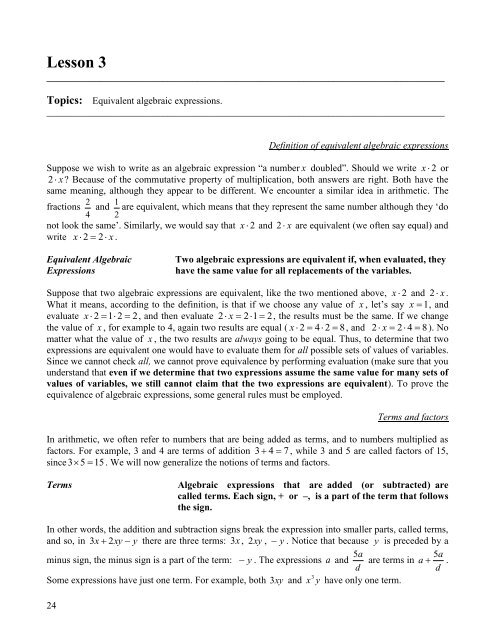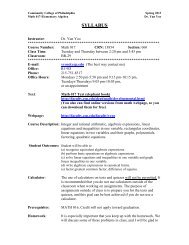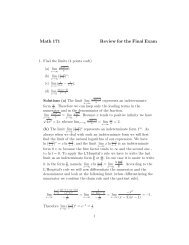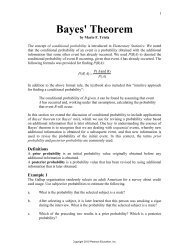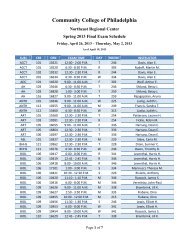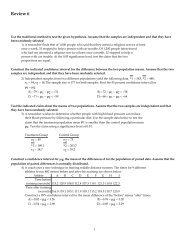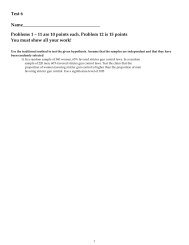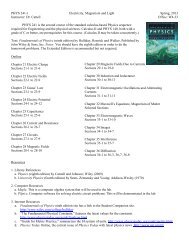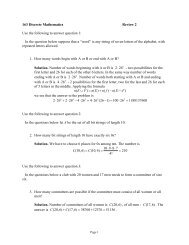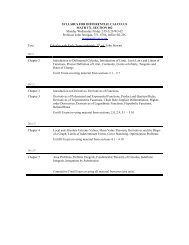Lesson 3__________________________________________________________________________________Topics: Equivalent algebraic expressions.__________________________________________________________________________________Definition of equivalent algebraic expressionsSuppose we wish to write as an algebraic expression “a number x doubled”. Should we write x 2 or2 x ? Because of the commutative property of multiplication, both answers are right. Both have thesame meaning, although they appear to be different. We encounter a similar idea in arithmetic. The2 1fractions and are equivalent, which means that they represent the same number although they „do4 2not look the same‟. Similarly, we would say that x 2 and 2 x are equivalent (we often say equal) andwrite x 2 2x .Equivalent AlgebraicExpressionsTwo algebraic expressions are equivalent if, when evaluated, theyhave the same value for all replacements of the variables.Suppose that two algebraic expressions are equivalent, like the two mentioned above, x 2 and 2 x .What it means, according to the definition, is that if we choose any value of x , let‟s say x 1, andevaluate x 2 12 2, and then evaluate 2 x 21 2, the results must be the same. If we changethe value of x , for example to 4, again two results are equal ( x 2 42 8, and 2 x 24 8 ). Nomatter what the value of x , the two results are always going to be equal. Thus, to determine that twoexpressions are equivalent one would have to evaluate them for all possible sets of values of variables.Since we cannot check all, we cannot prove equivalence by performing evaluation (make sure that youunderstand that even if we determine that two expressions assume the same value for many sets ofvalues of variables, we still cannot claim that the two expressions are equivalent). To prove theequivalence of algebraic expressions, some general rules must be employed.Terms and factorsIn arithmetic, we often refer to numbers that are being added as terms, and to numbers multiplied asfactors. For example, 3 and 4 are terms of addition 3 4 7 , while 3 and 5 are called factors of 15,since35 15. We will now generalize the notions of terms and factors.TermsAlgebraic expressions that are added (or subtracted) arecalled terms. Each sign, + or –, is a part of the term that followsthe sign.In other words, the addition and subtraction signs break the expression into smaller parts, called terms,and so, in 3 x 2xy y there are three terms: 3 x , 2 xy , y . Notice that because y is preceded by a5a5aminus sign, the minus sign is a part of the term: y . The expressions a and are terms in a .d dSome expressions have just one term. For example, both 3 xy and x 3 y have only one term.24
FactorsAlgebraic expressions that are multiplied are called factors.The expression 4 mn has factors 1, 4, m, n and any combination of those, like 4 m , 4 n , and of course,22224 mn . In ab , the expressions a and b are called factors but 1, b, b , ab, ab are also factors of thisexpression. During our study we will be talking about explicit factors. Explicit factors of 4 mn are 4,m and n, i.e. the factors that are separated by the multiplication sign (displayed or not displayed) of an22expression. Explicit factors of ab are a and b . The expressions 2x 3 and x 4 are explicit factorsin ( 2x 3)( x 4).Example 3.1 List all terms of the following expressions.a) 3 y zb)x 3x2 4( z 1)2Solution:a) The terms are 3, y, z . Remember that signs are always a part of terms.We list y as a term (y is preceded by the minus sign).xb) The terms are 3 2 2 x x ,4( z 1), . Notice the minus sign in 3x and ,22and that the expressions 4(x 1)should be viewed as one term.Example 3.2 List all explicit factors of the following multiplication.a) 5 abb) 3(a 1)xSolution:a) Since 5 ab 5 a b, the explicit factors are 5 , a, b.b) Since 3 ( a 1)x 3( a 1)b, the factors are; 3,( a 1)and x . Noticethat when listing factors, the expressions in parentheses are treated as one “unsplitable”expression.Algebra is an abstract generalization of arithmetic, where numbers are ‘replaced’ with variables. Thelaws that are true for numbers also hold for algebraic expressions (recall, algebraic expressions aremerely symbolic representations of numbers).We will discuss some of the laws in the context of equivalent expressions.Commutative property of addition: rearranging terms results in equivalent expressionsWe know that 3 5 and 5 3 are both equal to the same number, 8. It is because the result of additiondoes not depend on the order of numbers that are being added. This property is called the commutativeproperty of addition. Remember, subtraction does not have this property: 5 3 35 . But, if we viewsubtraction as the addition of the opposite number, we get 5 3 5 ( 3) 3 5 . <strong>With</strong> the use ofvariables, we can express the above ideas in a general form (without the use of specific numbers). Forany value of x and y,25
- Page 1 and 2: Math 017MaterialsWithExercises
- Page 3 and 4: TABLE OF CONTENTSLesson 1Variables
- Page 5 and 6: Lesson 1___________________________
- Page 7 and 8: e) „minus x ‟ or „the opposit
- Page 9 and 10: For example,Evaluate 5 x when x 10
- Page 11 and 12: 3xd) x( y)e) 2f) 2x yz w(t)Ex.4 T
- Page 13 and 14: Ex.16 Let x 3. Rewrite the express
- Page 15 and 16: e) x5f) x2Ex.28 Substitute“undefi
- Page 17 and 18: Lesson 2___________________________
- Page 19: Solution:Please, notice the use of
- Page 22 and 23: g)i)4( a 2)h)8y (x)4(ab)j) ( a d)
- Page 24 and 25: 1 2Ex.19 If possible, evaluate when
- Page 28 and 29: Commutative Propertyof Additionx y
- Page 30 and 31: 2 x 2 xFor example, and thus als
- Page 32 and 33: Example 3.10 Determine which of the
- Page 34 and 35: Exercises with Answers (For answers
- Page 36 and 37: Ex.16 Write the following expressio
- Page 38 and 39: s) ( 0.2xy)( 0.3z)t)4x1Ex.24 Is 1
- Page 40 and 41: Lesson 4___________________________
- Page 42 and 43: Numerical coefficientsNumerical Coe
- Page 44 and 45: For your convenience, we will displ
- Page 46 and 47: 9 818081a) 9 98097 6 76134 4 4 4
- Page 48 and 49: Ex.8Simplify by raising to the indi
- Page 50 and 51: 73a 2xxi) 2aj)2( 42a)x(3xk)4x2 ) 3
- Page 52 and 53: Lesson 5___________________________
- Page 54 and 55: FactorizationThe Distributive Law l
- Page 56 and 57: Simplification of algebraic fractio
- Page 58 and 59: Mistake 5.1When factoring 3 from 3x
- Page 60 and 61: Ex.13 Factor2a) 5 a from the follow
- Page 62 and 63: 24x ( 5x)g)xa bi)7(a b)bc ( b e)
- Page 64 and 65: Adding and subtracting like termsIf
- Page 66 and 67: ) This should be written as 4x 2
- Page 68 and 69: Ex.4 Circle all terms that are like
- Page 70 and 71: 682 122k) 6 ( d a) a dl) 3a1(4a
- Page 72 and 73: Lesson 7___________________________
- Page 74 and 75: For instance, the area of a rectang
- Page 76 and 77:
a) a b 2bc) a bd) ae)b)aba 22a a
- Page 78 and 79:
Ex.24 Express the expressiona) m s
- Page 80 and 81:
A solution, the solution set, and w
- Page 82 and 83:
■ Solve the following equation 3x
- Page 84 and 85:
sides (subtracting 4 x from both si
- Page 86 and 87:
Mistake 8.2While solving an equatio
- Page 88 and 89:
Ex.12 Determine whether the followi
- Page 90:
Lesson 9___________________________
- Page 94 and 95:
xy x 1 yFactor x .x( y 1)1yDivide
- Page 96 and 97:
a) b b) a c) tEx.15. SolveEx.16. So
- Page 98 and 99:
For each number you should check if
- Page 100 and 101:
■ Solve the inequality 4x 9 1.
- Page 102 and 103:
■ Solve the following inequality
- Page 104 and 105:
Ex.10 Graph the following number se
- Page 106 and 107:
d) z 3e) z 13 Ex.22 Knowing x 1
- Page 108 and 109:
Example 11.2 The expression( 22 2x
- Page 110 and 111:
Solution:a) To match the form y mx
- Page 112 and 113:
a x and b 3 , so now we can rewri
- Page 114 and 115:
Ex.9 For each of the following expr
- Page 116 and 117:
114xc) y 5d) y 3x 2 0e) 3y 6x1f
- Page 118 and 119:
APPENDIX A:Lesson 1ANSWERS TO EXERC
- Page 120 and 121:
49C 3255 2(L+W)62mc75a) a b expon
- Page 122 and 123:
3(m n)a(x1)g)h)2tx19s s s sThe opp
- Page 124 and 125:
52233x1 2 x5 3 1513 a) m ( 2m) 2mb
- Page 126 and 127:
c) Numerator: one term, 3ab (with t
- Page 128 and 129:
18 a) 9 b) 3 c) 3 d) 3e) 6 f) 279
- Page 130 and 131:
11 a) x 1 b)12 a) x abcx a b42 b
- Page 132 and 133:
c) x 2d) a 7e) x 10f) a 225 a)
- Page 134 and 135:
x or 4x ( 7) 0; a 4; b 7g) x (
- Page 136 and 137:
3. Let m = ─3. Evaluate the follo
- Page 138 and 139:
1. Write the following statements a
- Page 140 and 141:
6. Solve the following equations:8.
- Page 142 and 143:
8. Factor the following expressions
- Page 144 and 145:
___________________________________
- Page 146:
3 ;b) x 3 y 6 xy 2 A xy 28. a) x


